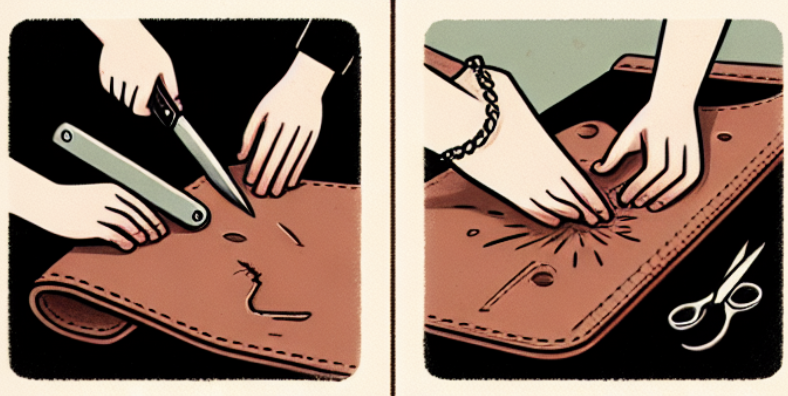Common Mistakes with Leather to Avoid
Introduction
Leather has long been a staple in the fashion and craft industries. Its durability, versatility, and timeless appeal make it a preferred material for everything from belts and bags to intricate jewelry. Leather cords, in particular, are a favorite among artisans and small business owners due to their adaptability and strength. However, working with leather and leather cords isn't without its pitfalls. Understanding what not to do can mean the difference between a sleek, enduring product and one that quickly falls apart. In this blog post, we'll explore common mistakes people make with leather and leather cords and offer insights on how to avoid them.
Using Low-Quality Leather
Impact on Durability and Aesthetics
Choosing low-quality leather might seem like a cost-saving measure initially, but it can significantly affect the durability and aesthetics of your final product. Low-quality leather tends to crack, fade, and wear out quickly, which can be disastrous for items intended to last. It often lacks the supple texture and rich appearance that high-quality leather offers, leading to a less appealing end product.
How to Identify Quality Leather
Identifying high-quality leather requires a bit of knowledge and experience. Look for full-grain or top-grain leather, which retains the hide's natural surface and is more durable than split or bonded leather. The smell is another indicator; genuine leather has a distinct, rich scent, unlike synthetic alternatives. Pay attention to the stitching and edges; high-quality leather is often hand-stitched and has clean edges.
The Cost of Low-Quality Leather
While high-quality leather may come with a higher price tag, it offers better value in the long run. Items made from superior leather not only last longer but also age beautifully, developing a unique patina over time. Investing in quality leather ensures your products remain stylish and functional, providing better satisfaction for both creators and consumers.
Neglecting Proper Storage and Maintenance
Tips for Maintaining Leather Quality
Proper storage and maintenance are crucial to preserving the quality of leather. Store leather items in a cool, dry place away from direct sunlight, which can cause fading and cracking. Use breathable fabric covers instead of plastic bags to prevent moisture buildup. Regularly clean and condition your leather to keep it supple and prevent drying.
The Consequences of Poor Storage
Failing to store leather properly can lead to irreversible damage. Exposure to excessive moisture can cause mold and mildew, while dryness can lead to cracking and brittleness. Neglected leather loses its luster and flexibility, diminishing the overall appearance and functionality of the item.
Best Practices for Leather Maintenance
Develop a routine for cleaning and conditioning your leather goods. Use a soft brush or cloth to remove dirt and dust, and apply a quality leather conditioner to keep the material moisturized. For spills and stains, act quickly to blot the area with a clean cloth and avoid using harsh chemicals that can damage the leather.
Overlooking Eco-Friendly and Sustainable Practices
The Importance of Ethically Sourced Leather
In today's environmentally conscious world, sourcing leather ethically is more important than ever. Ethically sourced leather comes from suppliers who follow sustainable practices, ensuring the welfare of animals and minimizing environmental impact. Choosing eco-friendly leather supports sustainable agriculture and promotes responsible consumption.
How to Find Sustainable Leather Suppliers
Look for suppliers who provide transparency about their sourcing and production methods. Certifications such as the Leather Working Group (LWG) certification indicate adherence to environmental best practices. Research the supplier's commitment to sustainability and ethical treatment of animals to ensure you're making a responsible choice.
Benefits of Sustainable Leather
Using sustainable leather not only benefits the environment but also enhances your brand's reputation. Consumers are increasingly seeking products that align with their values, and offering eco-friendly leather options can attract a loyal customer base. Sustainable leather also tends to be of higher quality, as responsible practices often go hand-in-hand with meticulous craftsmanship.
Misunderstanding Leather Grades
Differentiating Leather Grades
Understanding the different grades of leather is essential for choosing the right material for your project. Full-grain leather is the highest quality, known for its durability and natural imperfections. Top-grain leather is slightly corrected for a smoother finish, while split leather is made from the lower layers and is less durable. Bonded leather, made from leftover scraps, is the lowest grade and least durable.
Choosing the Right Grade for Your Needs
Selecting the appropriate leather grade depends on the intended use of the item. Full-grain leather is ideal for high-wear items like belts and bags, while top-grain leather is suitable for more refined products like wallets and shoes. Split and bonded leather can be used for budget-friendly options but are best avoided for items requiring high durability.
The Impact of Leather Grades on Final Products
The grade of leather you choose directly affects the quality and longevity of your final product. High-grade leather not only looks and feels better but also withstands wear and tear more effectively. Investing in quality leather grades ensures your products meet the highest standards and provide lasting satisfaction to your customers.
Not Considering the Right Leather Cord Thickness for Projects
Matching Cord Thickness to Project Requirements
Choosing the right leather cord thickness is crucial for the success of your project. Thicker cords provide more strength and durability, making them suitable for items like belts and straps. Thinner cords offer flexibility and are ideal for detailed work like jewelry and lacing. Matching the cord thickness to your project ensures the final product is both functional and aesthetically pleasing.
Common Mistakes with Cord Thickness
One common mistake is using a one-size-fits-all approach to cord thickness. This can lead to issues like weak joints, fraying, or a bulky appearance. Another mistake is not considering the weight and stress the cord will endure, which can result in premature wear and tear.
Tips for Selecting the Right Cord Thickness
When selecting leather cord thickness, consider the type of project, the weight it will bear, and the desired aesthetic. For heavier items like bags and belts, opt for thicker cords. For intricate designs and light-duty applications, choose thinner cords. Consulting with suppliers like Sun Enterprises can provide valuable guidance on the best cord thickness for your specific needs.
Best Practices for Leather and Leather Cord Use
Choosing the Right Leather Type and Cord Thickness
Successful leather projects start with selecting the right materials. Consider the type of leather and cord thickness that best suits your project. Full-grain leather is ideal for high-wear items, while top-grain leather offers a balance of durability and smoothness. Match cord thickness to the project's requirements, ensuring strength and flexibility where needed.
Proper Care and Maintenance Routines
Establishing a routine for leather care and maintenance prolongs the life of your leather goods. Regularly clean your leather with a soft brush or cloth, condition it to maintain suppleness, and store it properly to prevent damage. Implementing these practices ensures your leather items remain in pristine condition for years to come.
Embracing Sustainable and Eco-Friendly Approaches
Incorporating sustainable practices in leather usage and production is not only environmentally responsible but also beneficial for your brand. Choose ethically sourced leather, support suppliers committed to sustainability, and promote eco-friendly practices within your business. This approach resonates with eco-conscious consumers and enhances your brand's reputation.
Case Studies and Examples
Success Stories in Leather Usage
Several businesses and individuals have successfully leveraged leather and leather cords by avoiding common mistakes. For instance, a small artisan shop in Brooklyn gained a loyal following by using high-quality, ethically sourced leather and offering personalized products. Their commitment to quality and sustainability set them apart in a competitive market.
Effective Leather Cord Applications
Designers and crafters have created stunning pieces by carefully selecting the right leather cord thickness for their projects. A jewelry designer used thin leather cords to create intricate necklaces and bracelets, attracting attention at craft fairs and online marketplaces. Their attention to detail and quality materials ensured lasting customer satisfaction.
Lessons from Industry Leaders
Leading brands in the fashion and craft industries have demonstrated the importance of proper leather care and sustainable practices. By investing in high-quality materials and adhering to best practices, these brands have maintained their reputation for excellence and continued to thrive in a demanding market.
Conclusion
Understanding and implementing best practices with leather and leather cords is crucial for creating high-quality, durable products. Avoiding common mistakes like using low-quality leather, neglecting proper storage, and misunderstanding leather grades can significantly enhance the final product. By choosing the right materials, maintaining them properly, and embracing sustainable practices, you can ensure your leather goods stand the test of time.




